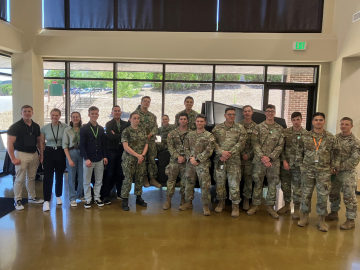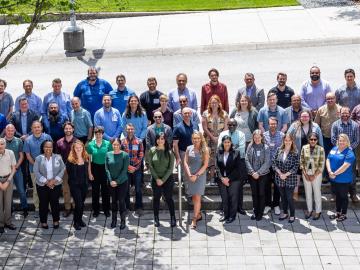
Filter News
Area of Research
- Advanced Manufacturing (3)
- Biological Systems (2)
- Biology and Environment (69)
- Building Technologies (1)
- Clean Energy (132)
- Climate and Environmental Systems (1)
- Computational Biology (1)
- Computational Engineering (3)
- Computer Science (14)
- Electricity and Smart Grid (2)
- Fuel Cycle Science and Technology (1)
- Fusion and Fission (27)
- Fusion Energy (13)
- Isotopes (2)
- Materials (50)
- Materials for Computing (13)
- Mathematics (1)
- National Security (55)
- Neutron Science (24)
- Nuclear Science and Technology (15)
- Quantum information Science (6)
- Sensors and Controls (1)
- Supercomputing (108)
- Transportation Systems (2)
News Type
News Topics
- (-) Bioenergy (90)
- (-) Computer Science (185)
- (-) Fusion (53)
- (-) Grid (61)
- (-) Machine Learning (46)
- (-) Molten Salt (8)
- (-) National Security (63)
- (-) Transportation (87)
- 3-D Printing/Advanced Manufacturing (116)
- Advanced Reactors (31)
- Artificial Intelligence (92)
- Big Data (51)
- Biology (99)
- Biomedical (57)
- Biotechnology (22)
- Buildings (52)
- Chemical Sciences (66)
- Clean Water (29)
- Climate Change (96)
- Composites (27)
- Coronavirus (45)
- Critical Materials (28)
- Cybersecurity (34)
- Decarbonization (74)
- Education (4)
- Element Discovery (1)
- Emergency (2)
- Energy Storage (103)
- Environment (184)
- Exascale Computing (37)
- Fossil Energy (6)
- Frontier (41)
- High-Performance Computing (84)
- Hydropower (11)
- Irradiation (2)
- Isotopes (51)
- ITER (7)
- Materials (136)
- Materials Science (131)
- Mathematics (9)
- Mercury (12)
- Microelectronics (4)
- Microscopy (47)
- Nanotechnology (54)
- Net Zero (13)
- Neutron Science (125)
- Nuclear Energy (101)
- Partnerships (49)
- Physics (58)
- Polymers (29)
- Quantum Computing (34)
- Quantum Science (67)
- Renewable Energy (2)
- Security (23)
- Simulation (47)
- Software (1)
- Space Exploration (25)
- Statistics (3)
- Summit (58)
- Sustainable Energy (122)
- Transformational Challenge Reactor (7)
Media Contacts

A study found that beaches with manmade fortifications recover more slowly from hurricanes than natural beaches, losing more sand and vegetation. The researchers used satellite images and light detection and ranging data, or LIDAR, to measure elevation changes and vegetation coverage. Changes in elevation showed how much sand was depleted during the storm and how much sand returned throughout the following year.

Benjamin Manard, an analytical chemist in the Chemical Sciences Division of the Department of Energy’s Oak Ridge National Laboratory, will receive the 2024 Lester W. Strock Award from the Society of Applied Spectroscopy.

Ten future U.S. Army officers recently visited ORNL to learn about the legacy of nuclear science. As students of the Nuclear Science and Engineering Research Center, or NSERC, with the Defense Threat Reduction Agency, or DTRA, they stopped in East Tennessee as part of a larger tour across nuclear facilities supporting the military. In Oak Ridge, they visited ORNL to gain an appreciation of the history of the Manhattan Project and how research at a national lab contributes new materials and electronics for the nuclear industry.

Prasanna Balaprakash, director of AI programs at the Department of Energy’s Oak Ridge National Laboratory, has been appointed to Tennessee’s Artificial Intelligence Advisory Council.

The world’s fastest supercomputer helped researchers simulate synthesizing a material harder and tougher than a diamond — or any other substance on Earth. The study used Frontier to predict the likeliest strategy to synthesize such a material, thought to exist so far only within the interiors of giant exoplanets, or planets beyond our solar system.
Joe Tuccillo, a human geography research scientist, leads the UrbanPop project that uses census data to create synthetic populations. Using a Python software suite called Likeness on ORNL’s high-performance computers, Tuccillo’s team generates a population with individual ‘agents’ designed to represent people that interact with other agents, facilities and services in a simulated neighborhood.

Two ORNL teams recently completed Cohort 18 of Energy I-Corps, an immersive two-month training program where the scientists define their technology’s value propositions, conduct stakeholder discovery interviews and develop viable market pathways.

Power companies and electric grid developers turn to simulation tools as they attempt to understand how modern equipment will be affected by rapidly unfolding events in a complex grid.

Researchers at the Department of Energy’s Oak Ridge National Laboratory and partner institutions have launched a project to develop an innovative suite of tools that will employ machine learning algorithms for more effective cybersecurity analysis of the U.S. power grid.

ORNL hosted the Mid-South Regional Chapter of the American Society for Photogrammetry and Remote Sensing, or ASPRS. Participants spanning government, academia and industry engaged in talks, poster sessions, events and workshops to further scientific discovery in a field devoted to using pictures to understand changes to the earth’s inhabitants and landscape.


